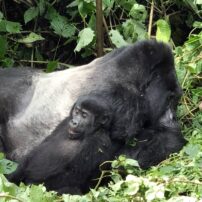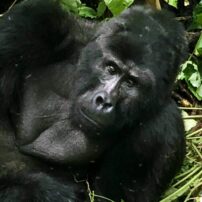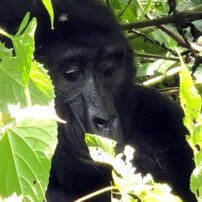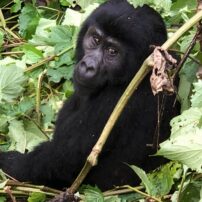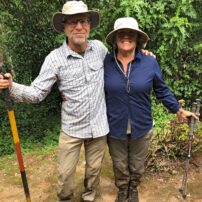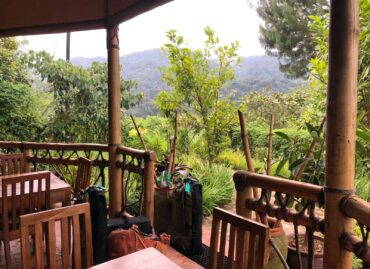
The mountains of Uganda and Congo bring to mind Hollywood stories like “King Kong” and “Gorillas in the Mist.” Known as the impenetrable jungle, this region makes trekking through dangerous and impossible without a guide.
The 1988 film about the life of conservationist Dian Fossey and her work with mountain gorillas in the jungles of Congo is a true story of one woman’s effort to keep the mountain gorilla from extinction. Today, preservationists agree that her work saved the mountain gorilla from extinction and opened the doors for gorilla tourism. And she gave her life doing so.
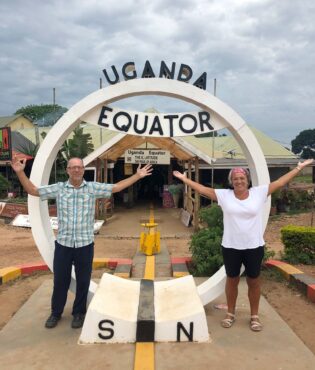
Most people have seen lowland gorillas in zoos. But the mountain gorilla has not survived in captivity, confounding zoologists. So, the only way to see these animals is to go to them.
In 1981, an estimated 250 mountain gorillas were left in the world. Thanks to conservation efforts, the population is now healthy and growing in all three countries where these creatures live (Uganda, Rwanda and the Democratic Republic of Congo). Today, the world population of mountain gorilla is near 1,100.
In 1991, conservationists and local wildlife rangers began the slow process of “habituating” certain groups of mountain gorillas to be comfortable when humans are nearby. This first effort took about two years, and in 1993, the first tourist trekkers came and gorilla tourism was born.
There are 36 gorilla families in Uganda’s Bwindi Impenetrable Forest National Park, with a total of about 650 gorillas, or half the world’s population. Of these, about 13 families are currently habituated for tourist trekkers.
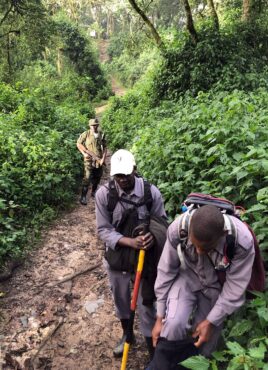
It’s not cheap to do a Uganda gorilla trek. It’s not easy either, but there are many options available to make it accessible to all physical abilities. For an additional $300, someone will literally carry you up the mountain in a kind of rickshaw, known as the gorilla helicopter.
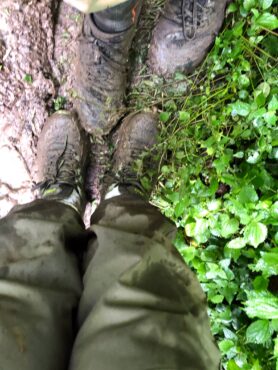
The high cost is mostly due to the permit fees required by the government. The money, of course, helps to continue saving these magnificent beasts, but at $600 per person for the permit alone, it’s beyond reach for many people.
Multiple operators work with the government and conservation organizations to bring visitors to the gorillas. One highly recommended tour operator is Achieve Global Safari of Uganda (achieveglobalsafaris.com).
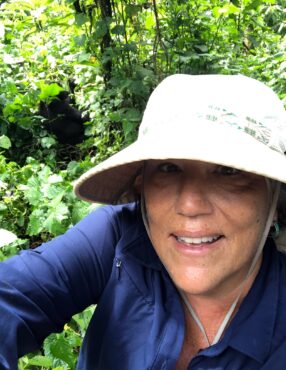
Through Achieve Global Safari, you can sign up for a trip length based on however long you want to be in Uganda. Achieve can take you beyond the Uganda Gorilla Trek and also show you many of the other wonderful animals and sights of Uganda. A five-day gorilla tour includes four nights lodging, all meals, a personal vehicle and guide, park entrance permits and all the staff it takes to get visitors up the mountain to the gorillas, for a total of $3,100 for two travelers.
Arrival is at Entebbe Airport and depending on arrival time, you will likely stay overnight in Entebbe or neighboring Kampala. Bright and early the next morning, you will embark on the 10-hour drive to Bwindi National Park.
It’s a long day of driving, but broken up with wildlife sightings, distant volcano viewing, equator crossing, miles of lush agricultural fields, delicious lunch and colorful villages and towns. Throughout this long drive, you will be gradually ascending into the Virunga Mountains near the Rwanda border.
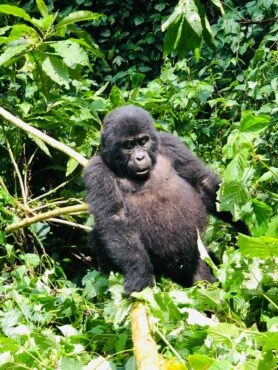
The drive reaches 7,800 feet, then comes down to 6,500 feet on arrival at the beautiful Chiumbi Gorilla Lodge. Small, lovely, comfortable, with exceptional service and food. A very nice touch is a hot water bottle placed in your bed every evening to keep you warm as the mountain temperatures drop.
Day three is the big day and you will be up before the sun to prepare for your trek. Following breakfast, head with your guide to the orientation site.
After a briefing by the ranger and some local entertainment, visitors are split into groups of eight and assigned to trek to one of the gorilla families. The families stay within a general “home” area, so advance tracking teams go out at sunrise, relaying the coordinates to the rangers.
Groups include a lead ranger and two armed guards, one forward and one aft. In addition, local porters can be hired ($15 minimum) to assist trekkers with their packs or to help them through the mud. This is the jungle, remember, and it can often be wet, muddy and slippery. Hiking poles are highly recommended, as are gloves to grab hold of branches and trees.
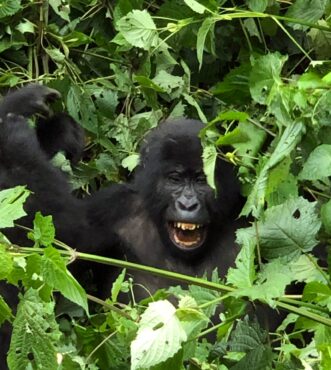
Part of the trek will be on a well-traveled trail, but to get to the animals, eventually you will need to leave the trail. The gorilla families don’t wait around near the trail, and they also don’t wait around for the tourists. They are often on the move and though most groups see the animals before the end of the day, some treks take a lot longer than others. Occasionally, groups don’t find the animals at all.
Leaving the trail means following your guide as he hacks through the jungle with a machete. Literal trailblazing, stumbling through the thick bush and vines. But suddenly, there they are.
Finding a gorilla family usually means several females and a handful of juveniles ranging in age from a few months to a few years. Then there is the patriarch of the family — the magnificent silverback.
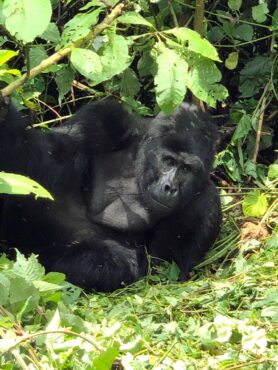
Your guide will position your group with the best possible view of the animals, anywhere from a few feet to 20 yards. And then you will enjoy an hour of viewing. This is what you worked so hard to get here for.
The females will possibly be napping after lunch, coddling newborns or admonishing toddlers. The juveniles will be playing, just like kids at recess, with older juveniles teaching the younger ones. Occasionally, the juveniles will jump up to perform for you — chest pounding is a favorite way to show off.
The incredible silverback will take your breath away. These beautiful creatures can live to be 40 years old and weigh nearly 500 pounds. Silverback mountain gorillas can grow as tall as 7.5 feet. The mature male sports a crest of fur on his head and the magnificent silver fur on his back.
For such a large and imposing creature, the silverback is gentle and tolerant of the youngsters who play around and on top of him while he rests and grazes. The creature is also surprisingly tolerant of the visitors, but the armed guards are always nearby.
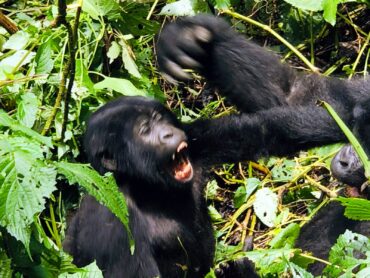
The money, the mud, the climbing through the bush — it’s all forgotten once you stand there, enjoying this unique experience. This real-life “Gorillas in the Mist.” A once-in-a-lifetime experience.
Visiting Uganda and trekking to the gorillas creates many jobs for locals — not just the guides, the rangers and the porters, but all the staff at hotels, restaurants, shops and gas stations. This on top of the money invested into the conservation of the gorilla through the work done by the African Wildlife Foundation.
Uganda is a beautiful and incredibly green country, with UNESCO recognizing its biodiversity. The country still has political challenges, and the Entebbe airport needs upgrades. But Uganda is poised to be the next big safari destination. Your dollars help the friendly and welcoming people and the animals, and help save the habitat of these incredible creatures for generations to come.




